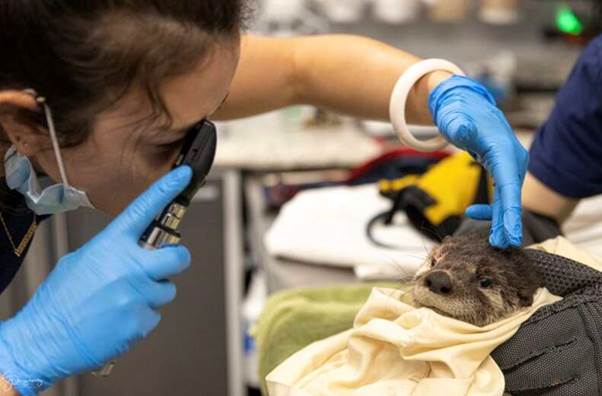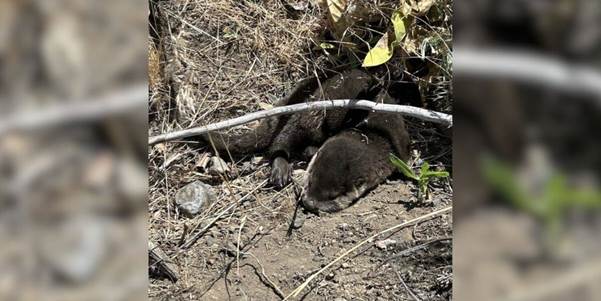A Furry Discovery in the Ditch
On a quiet June morning at Oregon’s Cove Palisades State Park, ranger Tyler Banks was making his usual rounds when something unusual caught his eye. In a shallow roadside ditch, what looked like a small, fuzzy brown lump was curled up motionless. At first glance, it could have been a pile of leaves or even a lost piece of clothing. But Tyler’s instincts told him to investigate.
As he approached, the shape stirred, and he realized it was no ordinary object. Instead, he was staring at two tiny river otter pups, orphaned and completely alone. Frail and vulnerable, the pups were in desperate need of help.
Recognizing the urgency of the situation, Banks quickly contacted a state police wildlife officer. Within hours, the frightened sisters were on their way to Think Wild, a rescue and rehabilitation center that specializes in caring for Oregon’s native wildlife.

First Steps Toward Healing
At Think Wild’s animal hospital, the pups received lifesaving care. Staff immediately worked to stabilize them — providing hydration, a full medical exam, and gentle monitoring. Both were weak, but their fighting spirit shone through.
The team faced a delicate challenge: how to save the pups while ensuring they would not grow too accustomed to human care. Director of Wildlife Rehabilitation Pauline Hice explained why this balance is critical.
“River otters are highly intelligent and can easily become habituated to humans if proper precautions are not taken,” Hice noted. “If they begin to associate people with food or safety, they cannot safely or humanely return to the wild.”
For this reason, the caregivers used protective measures to minimize contact. They kept their voices low, avoided unnecessary handling, and made sure the otters did not link humans to comfort. Instead, the pups leaned on one another — huddling close, cuddling, and finding strength in their sibling bond.

Growing Stronger and Learning Survival Skills
As weeks passed, the pups regained their health. Once they were stable enough, they were transferred to the Wildlife Center of the North Coast for a longer rehabilitation period. Here, experts carefully introduced them to the skills they would need for life outside human care.
They practiced swimming in controlled pools, learned how to search for food, and gradually built the endurance required for survival in Oregon’s waterways. Rehabilitation was not just about physical strength — it was about restoring their natural instincts so they could thrive on their own.
Months later, after careful monitoring, experts agreed: the otter sisters were ready. They had learned enough to be released back into the wild.

A Careful Release Back to Freedom
In a heartwarming full-circle moment, the pups were transported back to Think Wild, where staff prepared to reintroduce them to their original home range. To give them the best chance at success, the team opted for a soft release — a gradual process that allows animals to adjust before full independence.
Rescuers installed a temporary den near the water and provided limited food support through a specially designed port that avoided direct human interaction. This method allowed the otters to experience freedom while still having a safety net during their transition.
“This transition period is crucial for their survival,” Hice explained. “By providing this additional support, we’re giving these otters the best possible chance at a successful return to the wild.”
When the time finally came, staff opened the den and watched as the two sisters scurried toward the river, their sleek bodies gliding into the water with confidence. It was the moment everyone had been waiting for — the pups were home.
Think Wild shared the joyous update with supporters on Facebook:
“Now, these two otter pups are back where they belong — exploring their new river home!”
What began as a routine patrol became a life-changing moment for two young otters. Thanks to one ranger’s keen eye and the dedicated care of wildlife rescuers, the sisters were given not just a second chance at survival, but the opportunity to return to the wild where they belong.
Their story is a reminder of how closely connected people are to the animals around them. A simple act of awareness can mean the difference between life and death for vulnerable wildlife. And with compassion, patience, and expertise, even the smallest creatures can find their way back to freedom.
As they explore their river home once again, the otter sisters carry with them the love and protection of everyone who refused to let them go unnoticed.


